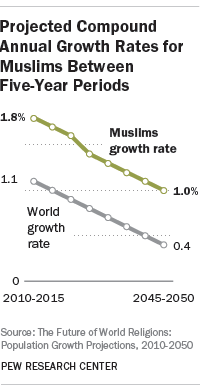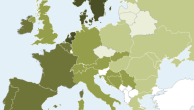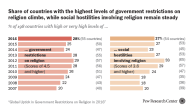
The number of Muslims around the world is projected to increase rapidly in the decades ahead, growing from about 1.6 billion in 2010 to nearly 2.8 billion in 2050.40 Muslims are expected to grow twice as fast as the overall global population. Consequently, Muslims are projected to rise from 23% of the world’s population in 2010 to 30% in 2050.41

This significant projected growth is largely due to the young age and high fertility rate of Muslims relative to other religious groups.
The annual growth rate of Muslims is expected to be considerably higher than the rate for the world as a whole. In 2010-2015, the expected Muslim growth rate is 1.8% while the rate for the world’s population is 1.1%. Both rates are expected to decline over time. In 2045-2050, for example, the annual growth rate of Muslims is projected to be about 1% while it will be 0.4% for the world.
Regional Change

Looking to the future, the Asia-Pacific region is expected to remain the home of a majority of the world’s Muslims. However, the share of the global Muslim population living in several Asian countries with large Muslim populations (such as Indonesia, Pakistan and Bangladesh) is anticipated to decline between 2010 and 2050. While 62% of the world’s Muslims lived in Asia and the Pacific in 2010, 53% are projected to live in the region in 2050.
The Middle East-North Africa region is predominantly Muslim, but as of 2010, only one-in-five Muslims lived in that part of the world. By 2050, about the same share of the global Muslim population is expected to live in the Middle East and North Africa (20%).
Sub-Saharan Africa is projected to have a significantly larger share of the world’s Muslims in 2050 compared with 2010. About 24% of the world’s Muslims are expected to live in sub-Saharan Africa in 2050, up from nearly 16% in 2010.
Muslim populations are expected to grow in absolute number in all regions of the world between 2010 and 2050. In the Asia-Pacific region, for instance, the Muslim population is expected to reach nearly 1.5 billion by 2050, up from roughly 1 billion in 2010. The number of Muslims in the Middle East-North Africa region is expected to increase from about 300 million in 2010 to more than 550 million in 2050. The Muslim population in sub-Saharan Africa is forecast to more than double, growing from about 250 million in 2010 to nearly 670 million in 2050. The absolute number of Muslims also is projected to increase in regions with smaller Muslim populations, including Europe and North America.

Although a smaller share of the world’s Muslims are projected to live in the Asia-Pacific region in 2050 compared with 2010, the share of the region’s population that is Muslim is expected to grow from 24% in 2010 to nearly 30% in 2050. In fact, Muslims are projected to surpass Hindus and become the largest religious group in the Asia-Pacific region by 2050.
The share of the population in sub-Saharan Africa that is Muslim also is expected to grow in the coming decades, from about 30% in 2010 to 35% in 2050. Meanwhile, the overwhelming majority of the population in the Middle East and North Africa is projected to remain Muslim – increasing from about 93% of the region’s population in 2010 to 94% in 2050.

As a share of Europe’s population, Muslims are expected to nearly double, growing from about 6% in 2010 to about 10% in 2050. In North America, the share of the population identifying with Islam is expected to grow from 1% to 2% in the coming decades.
Between 2010 and 2050, the most rapid Muslim population growth in percentage terms is projected to occur in North America (197%) — more than seven times the expected increase in the region’s overall population (26%). The Muslim population in sub-Saharan Africa also is anticipated to grow more than in the region as a whole (170% vs. 131%).
With the bulk of the Middle East-North Africa region’s population being Muslim, the overall growth for Muslims there (74%) is expected to be about the same as the region overall (73%).
The Muslim population in Europe is expected to grow by 63% between 2010 and 2050, while Europe’s overall population is expected to decrease in size (minus 6%). During this period, the Muslim population in the Asia-Pacific region is expected to increase by 48% while the region’s population as a whole increases by 22%. The relatively small population of Muslims in Latin America and the Caribbean is anticipated to increase by 13% between 2010 and 2050, while the region’s overall population is expected to grow 27%.
Change in Countries With Largest Muslim Populations
Collectively, the 10 countries with the largest Muslim populations in 2010 are expected to account for roughly the same share of the world’s total population in coming decades (35% in 2050, compared with about 32% in 2010). In most cases, little change is expected in each country’s share of the global population. The one exception is Nigeria, where about 4% of the world’s population is expected to reside in 2050 (up from about 2% in 2010).

In eight of the 10 countries, the share of the population that is Muslim is expected to remain about the same. However, the Muslim share of the population is expected to increase in India and Nigeria. Muslims made up 14% of India’s population in 2010; they are expected to rise to 18% in 2050. Less than half of Nigeria’s population (49%) was Muslim in 2010, but Muslims are expected to make up a majority of the population (59%) in 2050.
As of 2010, Indonesia had the largest number of Muslims (about 209 million Muslims, or about 13% of the world’s Muslims), followed by India (176 million, or about 11%), Pakistan (167 million, 10%) and Bangladesh (134 million, 8%). Nigeria, Egypt, Iran and Turkey each also had more than 70 million Muslims in 2010.
With the exception of India, where Muslims are a minority religious group, and Nigeria, where Muslims made up nearly half the population, the other eight countries on the list each had a large Muslim majority in 2010. India is projected to have the world’s largest Muslim population in 2050 (311 million), while Pakistan is expected to have the second-most Muslims (273 million). Indonesia – the country with the largest number of Muslims in 2010 – is expected to fall to third place by 2050, with 257 million Muslims. Nigeria is forecast to rank fourth, with about 231 million Muslims at mid-century.
By 2050, Iraq and Afghanistan are expected to join the list of countries with the 10 largest Muslim populations. All told, more than six-in-ten of the world’s Muslims (62%) are projected to live in the 10 countries with the most Muslims in 2050, slightly smaller than the share of the world’s Muslims that lived in the top 10 countries in 2010 (66%).

Demographic Characteristics of Muslims That Will Shape Their Future
Fertility

With a Total Fertility Rate (TFR) of 3.1 children per woman, Muslims have higher fertility levels than the world’s overall population between 2010 and 2015 (2.5). High fertility is a major driver of projected Muslim population growth around the world and in particular regions. In every region for which data were available, the TFR for Muslims is at or above the replacement level of 2.1 children per woman (the number needed to maintain a stable population, all else being equal).
In every region except the Middle East and North Africa, Muslim fertility is higher than the rate for the region as a whole. Muslim women in sub-Saharan Africa, for example, have nearly one more child on average than women in the region overall between 2010 and 2015.
The countries with the highest Muslim fertility in the 2010-2015 period are concentrated in sub-Saharan Africa, including Niger (6.9), Nigeria (6.5), Somalia (6.3), Mali (6.1), Rwanda (6.0) and Malawi (6.0). The Muslim fertility rate in India (3.2) is around the same as the global rate for Muslims (3.1); in part because Muslims in Indonesia are having fewer children (2.0), India is expected to pass Indonesia and become the country with the world’s largest Muslim population by 2050. While Muslim fertility is well above replacement level in many countries, it is below replacement level in Iran (1.6) and in much of Eastern Europe, including Romania (1.5) and Russia (1.6).

Age Structure

Globally, Muslims were younger (median age of 23) than the overall population (median age of 28) as of 2010. Indeed, of all the religious groups included in this study, Muslims had the youngest median age as of 2010. The percentage of the population younger than 15 is another indication of the relative youth of a population. In 2010, 34% of the global Muslim population was under age 15, compared with 27% of the overall world population.

In the Asia-Pacific region, where about six-in-ten of the world’s Muslims live, the median age of Muslims (24) was five years younger than the median age of the region as a whole (29). Mostly owing to a high number of young immigrants and their children, Muslims in Europe (median age of 32) and North America (median age of 26) also were considerably younger than the general populations in these regions as of 2010.
Muslims in sub-Saharan Africa and the Middle East-North Africa region were similar in age to those regions’ general populations in 2010.
Religious Switching

In the Asia-Pacific region, the Middle East and North Africa and Latin America and the Caribbean, the projected Muslim share of the population in 2050 is about the same whether or not religious switching is taken into account in the population projections.
Religious switching only marginally changes the projected Muslim share of the population in North America, where the Muslim population is expected to be 0.2% smaller when religious switching is included in the projection scenario. This means that a small net loss of Muslims is occurring in North America through religious switching.
Meanwhile, net gains of Muslims through religious switching appear to be happening in sub-Saharan Africa and Europe. But again, they are not anticipated to significantly change the projected Muslim populations in these regions.
Migration

About 3.6 million Muslims are expected to move to a new region between 2010 and 2015, mostly coming from majority-Muslim countries in the Asia-Pacific and Middle East-North Africa regions. More than 1 million are forecast to move to Europe, including 600,000 from Asia and the Pacific and an additional 470,000 from the Middle East and North Africa.
At the same time, about 170,000 Muslims from the Asia-Pacific region and 120,000 from the Middle East-North Africa region are forecast to move to North America between 2010 and 2015. And more than 1 million Muslim migrants are expected to move from the Asia-Pacific region to the Middle East-North Africa region during this time period. These migration patterns are projected to continue in the decades ahead. (See the Methodology for more information on how migration flows were estimated.)
As Muslim migrants leave the Asia-Pacific and Middle East-North Africa regions, their movements are projected to decrease slightly the shares of those regions that are Muslim while increasing the Muslim shares of Europe and North America.
When migration is factored into the projection models, Muslims are expected to make up 10% of Europe’s population in 2050; without migration, the figure would be about 8%. For North America, when migration is considered in the projection models, the expected share of the region’s 2050 population that is Muslim is about one percentage point higher than it would be without migration (2% vs. 1%).





